Most people characterize Vincent van Gogh’s work for its bold, swirling strokes. But he was much more dynamic than just that. I have spent the last few weeks looking over his entire portfolio, including over 800 paintings, to get a feel for how he painted and his preferred techniques and processes. Here are my findings.
- Bold, Directional Brushwork and a Sense of Movement
- Outlining
- Pointillism
- Use of Color
- Speed
- Emotion and Stylization
- Same Subject, Different Conditions
- Thanks for Reading!
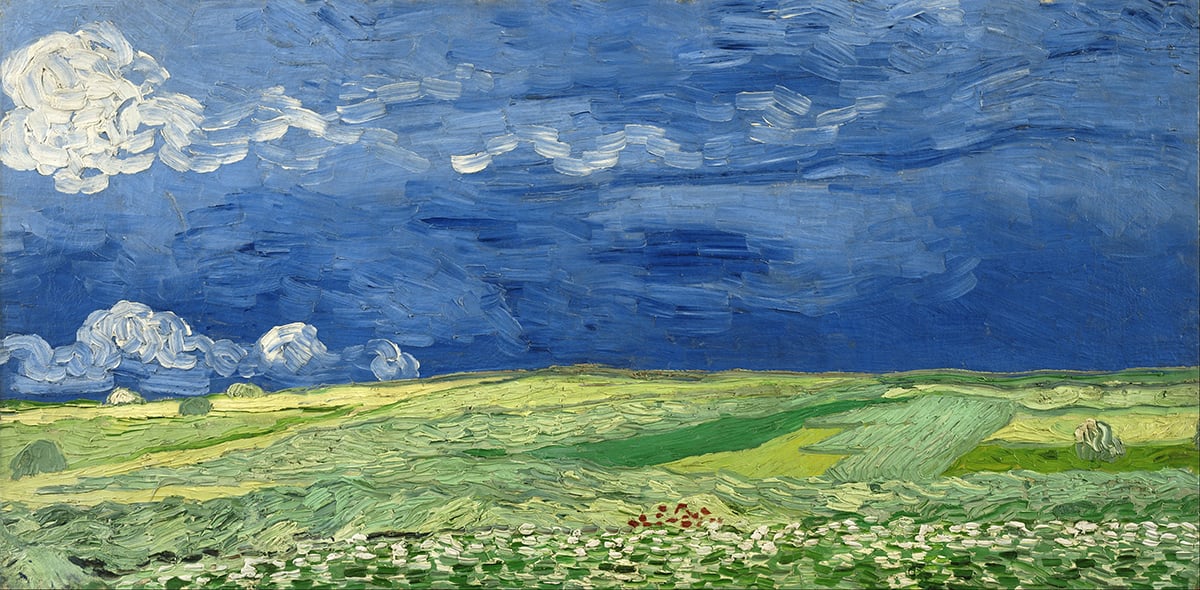
Bold, Directional Brushwork and a Sense of Movement
Let’s start with the obvious one: bold, directional brushwork. Most of his paintings feature this brushwork in some form or another. His strokes take you on a journey around the painting as they twist, turn, and swirl around the subject. This gives his work a unique sense of movement and vibration. The directional strokes also reiterate the subject’s form and contours.

For these bold directional strokes to work, van Gogh must have had an uncanny sense of movement and space. Take his iconic Starry Night, for example. He didn’t study physics, yet his depiction of the sky’s movement and turbulence is surprisingly accurate. (This video explains it well: The unexpected math behind van Gogh’s Starry Night.) That’s why his paintings read well, albeit dramatized.
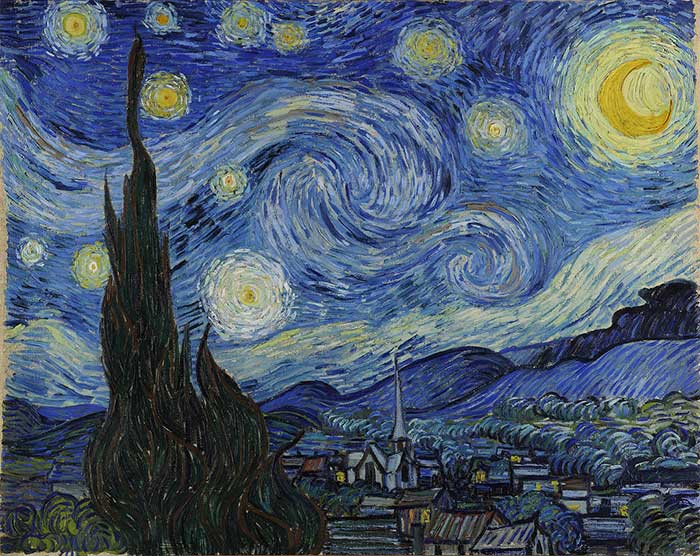
If you look closely, you’ll see that each bold and impasto stroke leaves tiny cast shadows and highlights on the painting. This adds a dynamic three-dimensional quality. As you move around the painting and look at it from different angles, its appearance will change slightly as the tiny shadows and highlights move and the impasto strokes become more or less pronounced (more pronounced from the side). I noticed this when I visited the van Gogh Museum in Amsterdam in my early 20s (no photos, sorry). I also saw it to a lesser extent at the European Masterpieces exhibition here in Brisbane. Van Gogh’s painting, The Flowering Orchard, was on display. It’s not his most textured work, but there are a few impasto strokes.

Below is a closeup I took. Can you spot the tiny cast shadows and highlights on individual strokes?
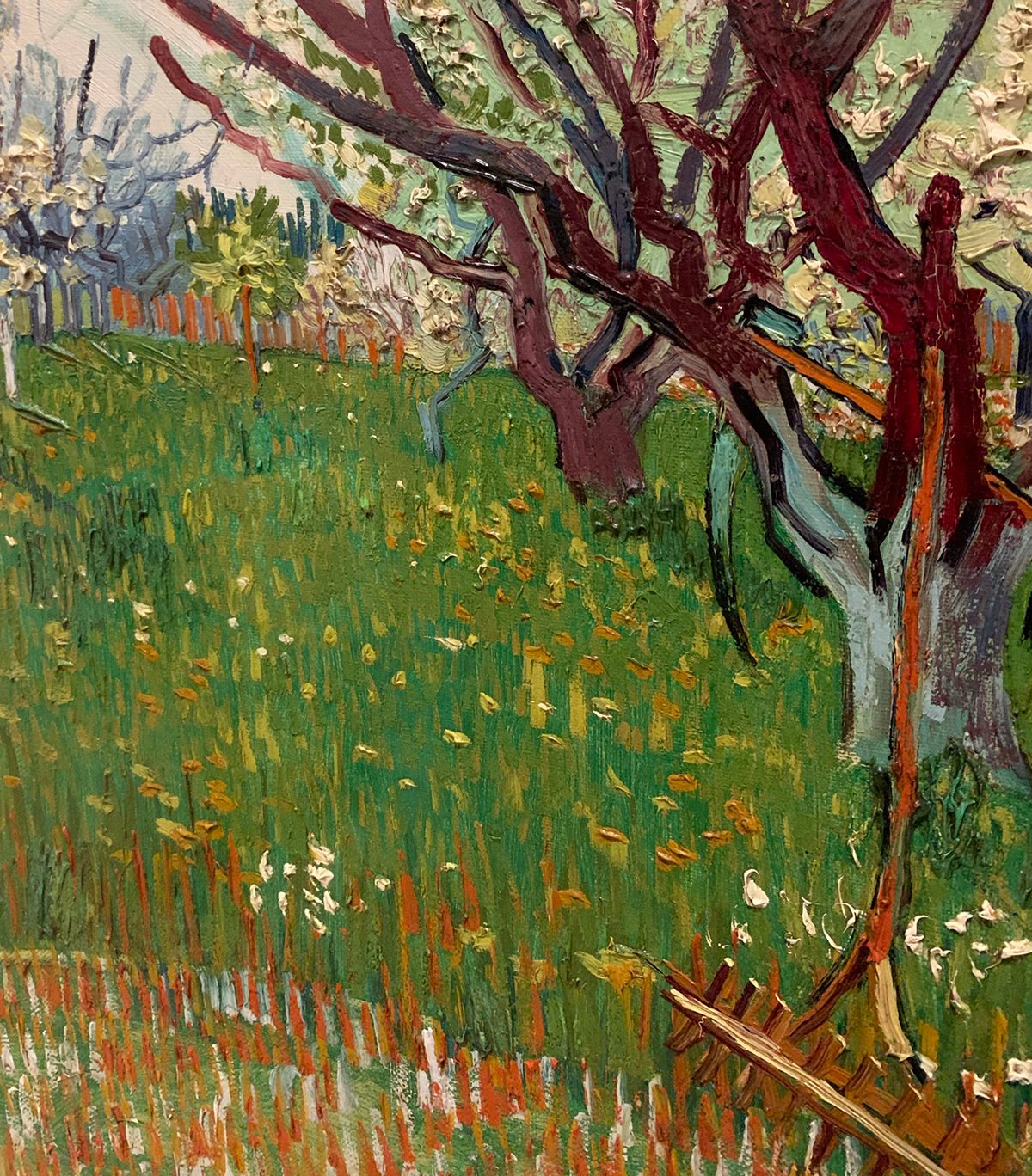
You can also see a high-resolution photo of the painting here. Make sure to zoom in on the details.
Outlining
Van Gogh often used dark outlining to accentuate objects. This was likely the influence of Japanese art and woodblock prints, which he was particularly fond of.

Outlining is a simple but powerful technique if you want something to stand out in your painting. But it’s more stylistic than realistic. We don’t see objects in the world neatly defined by dark outlines. They simply exist and there’s an immediate transition between one object and the surrounding colors. That’s why you don’t see outlining used as much by more realistic painters like John Singer Sargent or Joaquín Sorolla. They focus more so on tonal shifts to define objects. But it’s still a powerful technique to have in your back pocket, no matter your painting style.

I remember being inspired by van Gogh’s outlining in my painting, Montville, Tree in Mist. I used ultramarine blue outlines to help distinguish the fern leaves from the surrounding nature.

I also used van Gogh-like outlining and swirls in Maleny, Late Afternoon. I lifted paint from the surface with a cotton bud to create light outlines around the clouds.

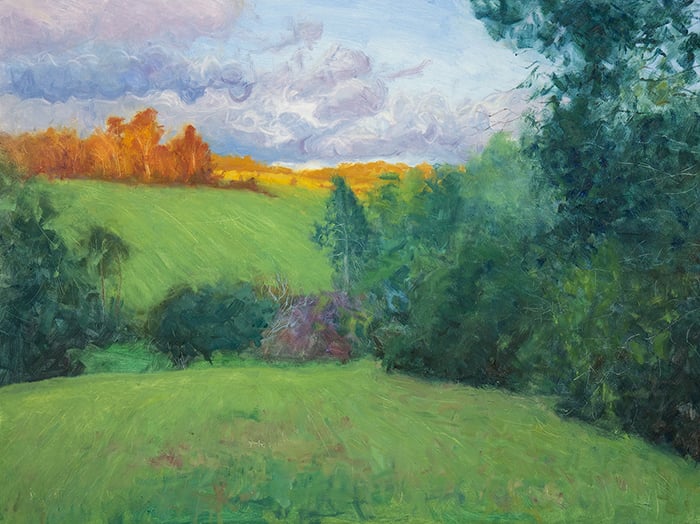
Tip: When exploring the work of other artists, you should always be on the lookout for techniques and processes you could adopt in your own work. This isn’t copying, as one technique doesn’t define an artist and you’ll invariably put your own spin on it. Over time, you’ll develop a vast and vertisile range of techniques at your disposal.
Pointillism
There are several examples of pointillism in van Gogh’s work. Pointillism being the use of many tiny dots or dabs of color to convey the subject.
He typically used it for busy and up-close nature compositions, such as Undergrowth. The colors vibrate and dance on the canvas and there’s a quality of realism about it, despite the strong stylization. Van Gogh also used the tiny dabs to convey movement and activity, as if the grass and leaves are blowing with the wind.

Another example of van Gogh’s pointillism is Interior of a Restaurant. He used it to inject life into the walls and floor. Notice how different color combinations suggest different surfaces.
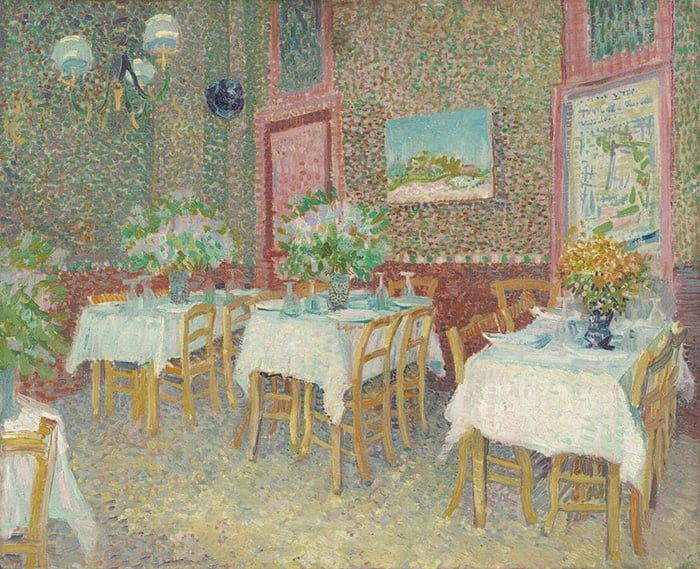
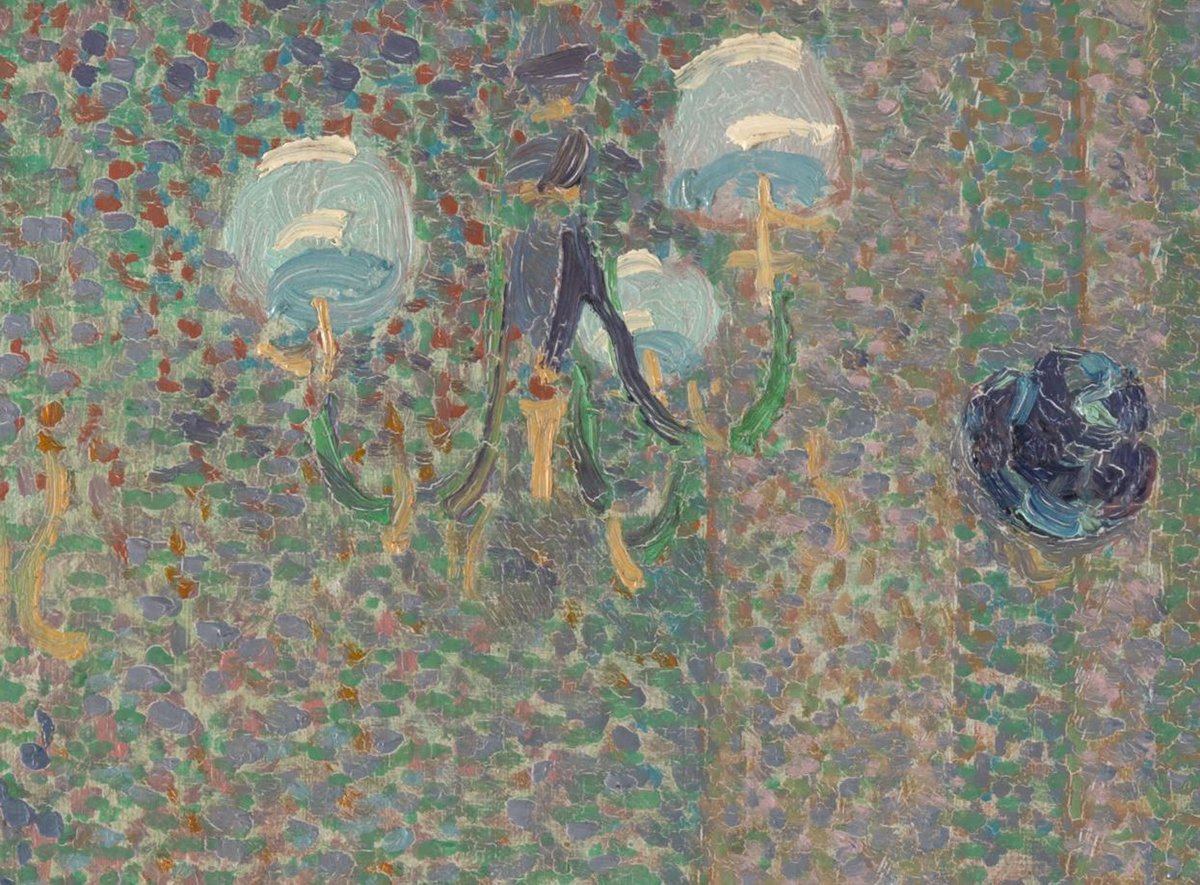
Most artists associated with pointillism—Georges Seurat, Paul Signac, Henri-Edmond Cross, etc.—were defined by the technique and used it exclusively in many of their paintings. But van Gogh used it more sparingly, often as just one of many other techniques. In Interior of a Restaurant, he used pointillism for the walls and floor and more refined brushwork and flat color shapes for everything else.
In his Lilac Bush painting below, he combined pointillism with dark outlining and a few flat color shapes. He also varied the nature of his brushwork to match the different parts of the subject. For the sky, he used more horizontal strokes; for the feature plants, he used more variance and contrast; for the grass at the bottom, he used punchy, vertical strokes.

Use of Color
Van Gogh started his art career with a dull and restrained color palette. Grays and browns dominate his early works. There’s also a sadness about them.

Around 1886, when van Gogh was in his early 30s, he found color and didn’t look back. If I had to pick a turning point, it would be his Le Moulin de la Galette painting, with its rich blues, reds, oranges, and greens.

At his best, van Gogh could push the colors as far as they could go without appearing garish or overdone. He did this by pushing in the direction of the subject and by following strong and logical color themes. He might use warmer and brighter colors for a sunset, richer blues for a clear midday sky, or more brilliant greens for plants and foliage. Whilst he did exaggerate and stylize the subjects, he always kept one foot in reality.

It’s also worth mentioning his fondness for yellow. Many of his paintings are a tribute to yellow’s brilliance.

Wheat Field With Reaper and Sun is particularly stunning. It glows like sunlight itself.

He also mentions yellow in many letters, often with quite vivid descriptions. In a letter to one of his sisters, he wrote:
“Now we are having beautiful warm, windless weather that is very beneficial to me. The sun, a light that for lack of a better word I can only call yellow, bright sulfur yellow, pale lemon gold. How beautiful yellow is!” – Vincent van Gogh
Letter to his sister, 1888 (Source)
Speed
Van Gogh worked fast. In just over a decade, he created over 2,000 drawings and paintings. His latter years were particularly prolific and yielded many of his most iconic works, such as Café Terrace at Night and Starry Night. It’s as if he was hit with a wave of ideas and creativity that he had to get out onto the canvas and knew he didn’t have much longer to work. Financial constraints may have also played a role, as painting fast may have meant less wasted paint from drying on the palette.
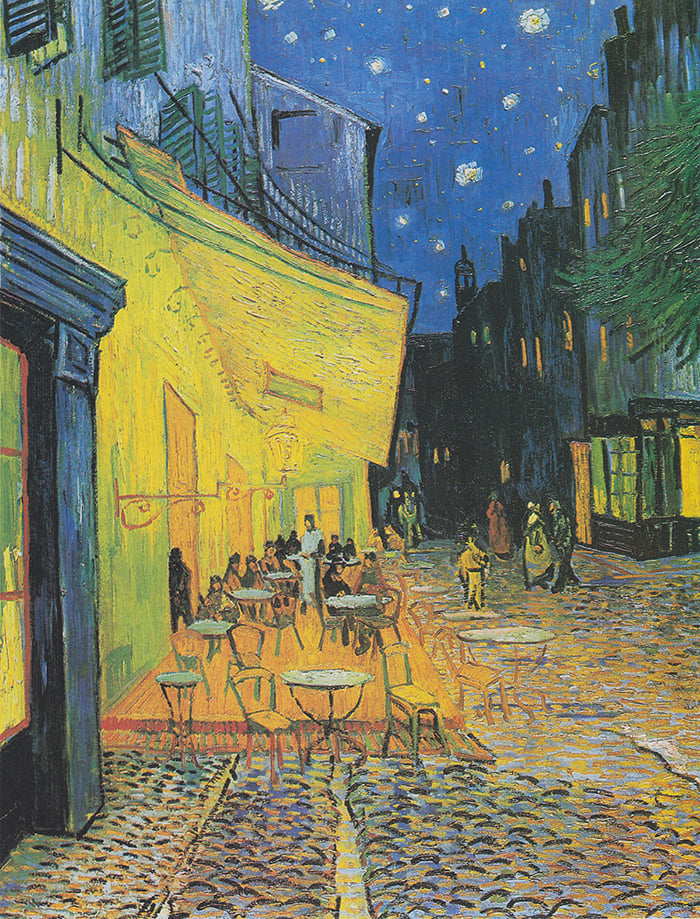
His rapid approach plays into the charm of his work. There’s a sense of spontaneity and honesty about it. It’s as though he didn’t have time to refine his thoughts and ideas; he just had to get them out onto the canvas.
It also likely influenced his choice of tools and techniques. He did whatever was necessary to achieve the desired marks. That included using palette knives, his fingers, paint straight from the tube onto the canvas, ratty old brushes, mixing on the canvas, and the blunt end of the brush. This is a good way to approach your tools. Be open-minded and remember that nothing is out of bounds. Don’t limit yourself to thinking that you must always use “X” tool to paint “Y” (like a fan brush to paint leaves).

Of course, this approach won’t work for everyone. In untrained hands, it will only lead to frustration and a mess on the canvas. To paint fast, you must have a level of experience and intuition to back it up. You may also simply prefer a more controlled and calculated approach, and that’s fine.
Emotion and Stylization
Van Gogh’s work has a strong emotional foundation. He didn’t just paint what he saw; he painted how he felt and experienced the subject. That’s why his work appears to be relatable and honest.

His paintings suggest he was quite sensitive to the world around him and all the emotions and feelings that come with it. I imagine he felt everything and he felt it strong, with his work ranging from deeply saddening portraits to colorful and cheery landscapes.

Tip: Observation is an essential part of being an artist, but that’s not limited to observing the physical world around us. It’s also about observing the more subtle aspects of life—the mood, atmosphere, and emotions.
Same Subject, Different Conditions
There are several examples of van Gogh painting the same subject over and over again under different conditions. Below are a few of his orchard paintings from 1888. Perhaps this was to study changes in light and color. Or perhaps he wanted to capture different aspects of the subject. Claude Monet also did this but on a much larger scale and with a keener and more apparent interest in color and light. If I had to guess, I would say van Gogh was more interested in exploring the emotion and character of the subject than the study of color and light.
It’s worth taking a brief look through this chronological list of van Gogh’s paintings to see common subjects and other patterns and themes.

Thanks for Reading!
I appreciate you taking the time to read this post and I hope you found it helpful. If you ever want to learn more, I invite you to join Color Masterclass. Enrollment is open for the next week.
Happy painting!
Dan Scott

Draw Paint Academy


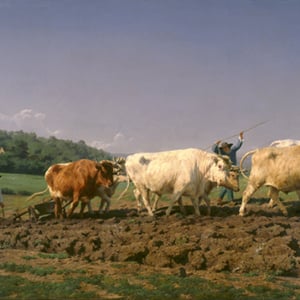
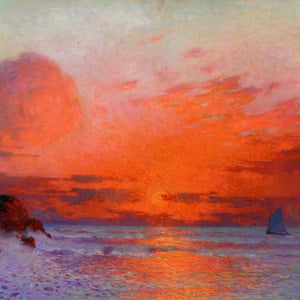
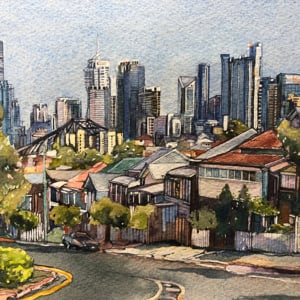
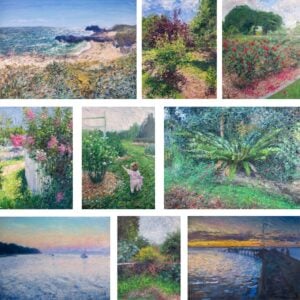
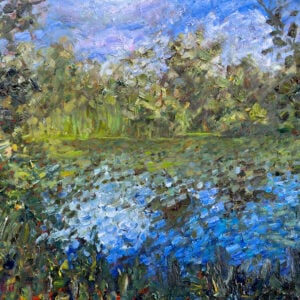
Thanks, Dan. This is interesting. And I haven’t seen some of these paintings before.
I like in the Iris one how, along with the outline, he’s created contrast by using shorter, more distinct brush strokes in the space around the plant (grass?) compared to the longer, more blended ones within it.
But then, I like pretty much all of these paintings. 😊
Wonderful understanding… like reading a painting🎨Ty for sharing!
Beautiful… like reading a painting🎨Ty for sharing!
Excelente, gracias muy muy interesantes técnicas en pinceladas , sombras , color etc
Your analyses of van Gogh are much appreciated. Did you get to see the electronic immersive and moving video of his works? It roamed the capital cities here and in other countries. I was moved to tears watching and listening to the haunting music that accompanied the morphing transitions from one painting to the next.
Great analysis, thank you. Just been to see the immersive experience, London. Would certainly agree his emotional focus whilst Monet more light (saw Monet immersive also!).
I got to experience the total immersion of that VanGogh exhibit in Montreal. Seventeen screens including the floor! I recommend it to those artists who are willing to be mesmerized by the man’s eyes huge on every screen when all his self portraits appeared together.
I saw it in New Zealand, although possibly a smaller version. One thing I loved about seeing the hugely magnified paintings was that you could see all the brush strokes. I also saw many drawings that I’d never seen before. And, yes, the music really made the event.
The only thing I didn’t like was some of the gimmicky stuff. I don’t know if they did this in other countries, but, in New Zealand, they had a thing called the Sunflower Room. It was a small room filled with plastic, not real(!), sunflowers and mirrored walls to make it look like a big field. Ugh. Apart from that, the event was great.
One day I’d love to see Vincent’s paintings in person.
Thank you so much I loved all the paintings.
Thank you so much Dan. I loved this article. I love the way you write in a very straight forward honest way. Its very interesting and helpful
It struck me that your collage of his orchard paintings felt like I was looking at my phone’s camera album where I take multiple shots of a landscapes to see if I can frame the best lighting and interest
Thank you very much for the lovely article, Dan! It was a lovely read, one that was quite interesting and charming. It feels real and relatable, and your language helped me to better understand van Gogh more as a person too, more than just a technical overview of his paintings! Much appreciated~
I wish I had read this before visiting the VanGogh museum in Amsterdam. It would have intensified an already moving experience. Great article! Thank you!
So interesting to read again and again about this colorful artist. Living brteeen Europe and Washinton DC I have a chance to see a lot of his artwork from his home country to National gallery or the Phillips Museum in DC! Colors, impasto, boldness is prominent and as you said an interesting tip for us artists to use/incorporate if we wish to. Thank you for taking the time yo provide this information
Thank you for making this analysis available. I really enjoyed reading it and seeing many photos I had not seen before. All the best to you and your wife in the New Year.
Thanks Dan.
Loved the article, very thorough. Thanks for the insight it’s really beneficial for me as an artist.
Completely agree!
I look forward to reading your emails.
Mary from Canada
Thank you, Dan, for your very insightful comments! Van Gogh! He brings us into the paintings with him. He almost involves all our senses?
Marcia Sewall
What a brillant study of Van Gogh very impressed by it all I feel I have a greater understanding of his work and appreciate his brilliance in showing the world a totally new way of seeing and feeling art
Thankyou Dan for sharing this wonderful experience
Thank you for sharing!
I wonder if he used outlining as a way to emphasise the spatial position of an object – in front of / behind – and so it performs the same role as a hard edge? When would one technique be more appropriate than the other?
Many thanks! I admire your teaching. You made me rediscover van Gogh afresh.
I really found your analysis of Van Gogh style of painting. Have tried to make replicas of his paintings and your analysis will be very helpful. Thanks and congratulations
I really found your analysis of Van Gogh style of painting. Have tried to make replicas of his paintings and your analysis will be very helpful. Thanks and congratulations I wish I could show you my paintings for your assessment
Wow. Nobody can analyze paintings like another artist!This was full of insights art historians and critics miss, all your points effectively (and beautifully) illustrated. I also loved your 2022 “tree in mist” one of your finest in my opinion. Thanks for this excellent presentation.
Insightful and very interesting assessment of Van Gogh’s work. you helped me see them more clearly. And I’ll be playing with some of these techniques. Thank you.
Your analysis of Van Gogh’s paintings and styles is brilliant. I will save this as a reference document and know I will be re-reading it many times to absorb all the the valuable observations you have shared.
I had an amazing experience a few years ago on a Seine River Cruise with my Mom. One of the towns we stopped in for a day was Auvers-sur-Oise where Van Gogh lived for the last few years of his life. We walked through the town and stopped at all of the sites where he painted. The church, the town hall, his apartment building where there are large signs posted with an image of his painting of that subject so you can compare the painting to the real thing.
The most amazing opportunity that day was an optional hike up the hill through the sugar beet fields to the crossroads where he painted “Wheatfield with Crows”!
https://www.vangoghmuseum.nl/en/collection/s0149v1962
I still have goosebumps from standing in the very spot where he would set up his easel and stool and paint every day! It was especially meaningful for me because I had just completed an Art History course in college and wrote a paper about that painting and how some say it is filled with metaphors about his short life. The crows, representing death, the crossroad leading into the field that is abruptly terminated… all so much to take in when you see it in person!
We also visited the cemetery where he and his brother are buried, side by side. It was an experience I will never forget. I have photos of my trip there that I would be happy to share if anyone is interested. ~ Patty Evans
Dan, what a fabulous review of Van Gogh’s work. The details were so so clearly described. I would love to see more of the same with other artist, like Monet or one you choose. Each would be an art appreciation dream. Great idea! Thank you for all you share.
Such a wonderful read about one of times’ famous artists. You are an excellent writer! I so appreciate your insights and sharing with us all. Thank you!
Dear Dan, I loved Van Gogh, now I love him much more after your writing.
Thank you very much
Sebastian
Very thorough presentation Dan. Thank you for your insight and guidance to seeing Van Gogh’s Stokes and color application to create his lasting works.
I live near Chicago and years ago was blessed to see the extensive exhibition of his works at The Chicago Art Institute. He was troubled and fought hard to find his niche. Always sketching. His father was a pastor and this influenced young Van Gogh, too. They moved a lot. At one time he lived in a house painted his favorite color: yellow!! I was so taken by this exhibit, to see those great original works gathered together. Your detailed presentation is appreciated and I love your study and appreciation to your own paintings. Well done!
Thank you so much Dan! Very interesting read on Van Gogh. Beautiful!
Thankyou. I enjoyed all paintings and comments
My favorite Van Gogh painting is “Wheatfield with Crows.” I understand was his last oil painting. I think everything he learned is in that painting. But you analysis shows me there was more great technique than we see in that final oll on canvas painting.
Thank you So Much.
I am 81 yrs . And paint 2 sessions a day when possible. I am very physically challenged, but have painted 40 years and your writings and material shown are very diff. From what I paint, but I want to say thank you so much for sharing. Also like to hear what others have to say. Have never had any teaching. Thank you so much.
magnifico y generoso estudio. Muchisimas gracias. Fue de gran utilidad su lectura. Volvere a re leerlo. Gracias otra vez
Dan,
I really enjoyed your commentary on the Van Gogh exibition. Your appreciation/love of art is wonderfully communicated, enlightening, and infectious!
Thanks so much for sharing, a great analysis and very accessible.
Very interesting to read of Van Gogh, his use of colours, yellows and how he used shadows in his brushwork. An absolute genius seen today by millions, understood by real and amateur artists alike… Love reading your intellectual commentary and analysis emails.. Glad of the great company.
Thank you Dan for sharing such a fascinating article
I had not seen some of the work that you featured.
I really look forward to receiving your emails
Very informative and interesting about Van Gogh. I have, during the Covid years, done many of his paintings turned into jigsaws. All quite hard but doable in the end.
Almond Branches in Bloom, however, defeated me. I spent 3 months in gaps between work and life, struggling to do under a 3rd and have finally given in. All blue and white and similar piece shapes became frustrating rather than pleasure. Back to art again!!
What a fascinating article! You’ve made me realise just how much I admire his work. Thank you.
I was taken with YOUR painting. Dan, you are getting to be SO good!
In the past, I have probably avoided delving into Van Gogh’s work due to its very public, commercial persona. Having tried the Immersive Experience in London after missing out on tickets to see the exhibition showing his ACTUAL work, my prejudice was confirmed. This money spinning enterprise shocked me with its crass, poorly presented excuse for analysis of his work and claim to ‘immersion.’ Your breakdown has lifted my spirits and should be compulsory reading for anyone looking for depth in the subject of Van Gogh, his colour and brushwork. I particularly like your observation that his loose, emotional response to the world does not need to be copied, but is one of many approaches to experiencing the world through the medium of paint. I am planning to examine, in more critical detail, the marks and colour choices made by the artists whose work resonates with me ( including your own) but also painters I have previously dismissed as “not for me”. I really like the idea of having this knowledge and understanding “in my back pocket” so thanks very much for sharing your expertise and analysis of this fine painter and helping me look beyond the obvious. I think Van Gogh would prefer it too!
Great article Dan. I love Van Gogh’s work and you certainly help me understand it more and see more in the paintings. I tried to do a Starry Night painting once from a photo I took at night on the bank in Arle. I was so excited to get to Arle on our river cruise thinking I would see the little yellow house only to learn it had been bombed during the war. Thanks for all your great emails. Always learn something.
Dan, thank you for all your comments on yours and other artists’ art , particularly enjoyed reading all your comments on Van Gogh’s paintings and techniques used. Extremely interesting. Took your short art course and now taking a drawing course in my town. Have dabbled in painting and cutting stained glass for mosaics while living in Costa Rica and now interested in drawing and painting. Thank you for all your painting information emails.
Just had the time to read your article, Dan. I love all Van Gogh work, but this compilation gives me new insight. I’m not school trained and have only been dabbling in paint, but love it so. I have tried to concentrate on water and trees, and feel like when I keep at one subject it improves. Maybe that’s why Van Gogh painted so many orchard scenes in a year?!
PS -the paintings you included are beautiful -Well done, Dan!
Thank you very much for the interesting article.I love Van Gogh . I really enjoyed seeing Coal Barges which I’ve never seen before!Beautiful!
Thank you,Sharon
Dan, I join the many others in thanking you for this excellent discussion of Van Gogh and his paintings. This last year I copied some of his paintings in order to better understand movement. He and Emily Carr taught me some good lessons. Your article here fills out what I learned, adding a new depth. You are so clearly a teacher! I am looking forward to learning more from you in the Color class.
I can’t thank you enough Dan for taking the time to present this valuable article to us.
That does show who you are as an artist as well as an instructor who is interested in the growth of the artistic style and skills of those who follow your lessons.
Your analysis of the article is superb. I intend to choose one or two of Van Gogh’s painting and try to follow his style and paint today.
I’ve been mostly a copyist when it comes to painting from reference photo. But now that you’ve taught us the importance of observance, I’ll try to do the best I can.
All the blessings for a bright and productive future in your paintings!
Thank you Dan for this valuable and insightful comments on Van Gogh paintings.
Thank you, Dan for sharing these! I’ve always loved Vincent’s work, but after seen the Immersion exhibit, I felt like I had been in those paintings! Using color as boldly as he did, scares me! Right now I am going through a phase of painting two things I love…lasnscapes and old steam engines! (Also hoping to find my niche to sell some paintings and also prints of them.. backgrounds of “the ground” befuddle me and end up looking flat. Maybe looking at Vincint some more can help my brushwork. Any suggestion??
Thank you again!!
I have finally started on your new course. Color is essential!!!!!
Dan. Thank you so very much for your insight. I’m a wannabe budding artist at 67 and my paintings have a ways to go. But your describing his techniques etc really inspires me to keep trudging along. I more than realize it’s all just for fun for me but I actually think I’m improving. Thanks again.
Fantastic article! Thank you!